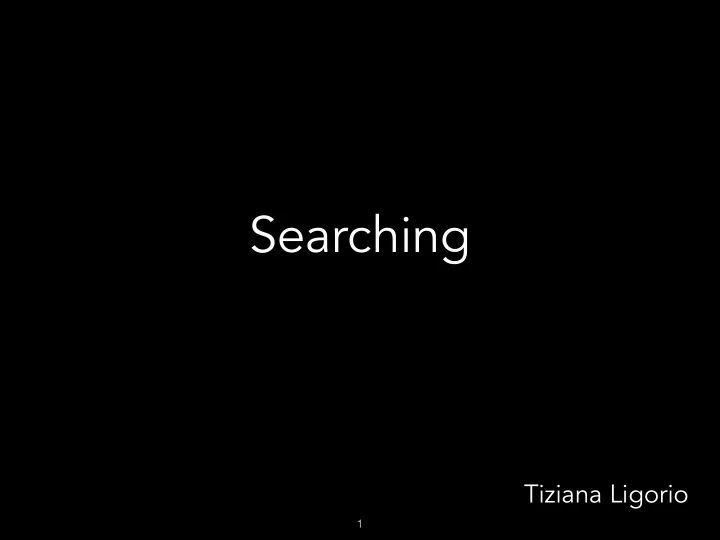

Searching Tiziana Ligorio � 1
Today’s Plan Searching algorithms and their analysis � 2
Searching Looking for something! In this discussion we will assume searching for an element in an array � 3
Linear search Most intuitive Start at first position and keep looking until you find it int linearSearch(int a[], int size, int value) { for (int i = 0; i < size; i++) { if (a[i] == value) { return i; } } return-1; } � 4
How long does linear search take? If you assume value is in the array and probability of finding it at any location is uniform, on average n/2 If value is not in the array (worst case) n Either way it’s O(n) � 5
What if you know array is sorted ? Can you do better than linear search? � 6
Lecture Activity You are given a sorted array of integers. How would you search for 115? ( try to do it in fewer than n steps: don’t search sequentially) You can write pseudocode or succinctly explain your algorithm � 7
We have done this before! When? � 8
Look in ? � 9
Binary Search 3 14 43 76 10 0 10 8 158 195 200 274 523 543 599 � 10
Binary Search 3 14 43 76 10 0 10 8 158 195 200 274 523 543 599 � 11
Binary Search 3 14 43 76 10 0 10 8 158 195 200 274 523 543 599 � 12
Binary Search 3 14 43 76 10 0 10 8 158 195 200 274 523 543 599 � 13
Binary Search 3 14 43 76 10 0 10 8 158 195 200 274 523 543 599 � 14
Binary Search 3 14 43 76 10 0 10 8 158 195 200 274 523 543 599 � 15
Binary Search 3 14 43 76 10 0 10 8 158 195 200 274 523 543 599 � 16
Binary Search What is happening here? � 17
Binary Search What is happening here? Size of search is cut in half at each step � 18
Binary Search What is happening here? Simplification: assume n is a power of 2 so it can be Size of search is cut in half at each step evenly divided in two parts The running time Let T(n) be the running time and assume n = 2 k T(n) = T(n/2) + 1 One comparison Search lower OR upper half � 19
Binary Search What is happening here? Size of search is cut in half at each step Let T(n) be the running time and assume n = 2 k T(n) = T(n/2) + 1 T(n/2) = T(n/4) +1 One comparison Search lower OR upper half of n/2 � 20
Binary Search What is happening here? Size of search is cut in half at each step Let T(n) be the running time and assume n = 2 k T(n) = T(n/2) + 1 T(n/2) = T(n/4) +1 T(n) = T(n/4) + 1 + 1 � 21
Binary Search What is happening here? Size of search is cut in half at each step Let T(n) be the running time and assume n = 2 k T(n) = T(n/2) + 1 1 2 1 T(n) = T(n/4) + 2 . . . 2 2 2 � 22
Binary Search What is happening here? Size of search is cut in half at each step Let T(n) be the running time and assume n = 2 k T(n) = T(n/2) + 1 T(n) = T(n/4) + 2 . . . T(n) = T(n/2 k ) + k � 23
Binary Search What is happening here? Size of search is cut in half at each step Let T(n) be the running time and assume n = 2 k T(n) = T(n/2) + 1 The number to which I T(n) = T(n/4) + 2 need to raise 2 to get n And we said n = 2 k . . . T(n) = T(n/2 k ) + k T(n) = T(1) + log 2 (n) n/n = 1 � 24
Binary Search What is happening here? Size of search is cut in half at each step Let T(n) be the running time and assume n = 2 k T(n) = T(n/2) + 1 T(n) = T(n/4) + 2 . . . Binary search is O(log(n)) T(n) = T(n/2 k ) + k T(n) = T(1) + log 2 (n) � 25
Recommend
More recommend